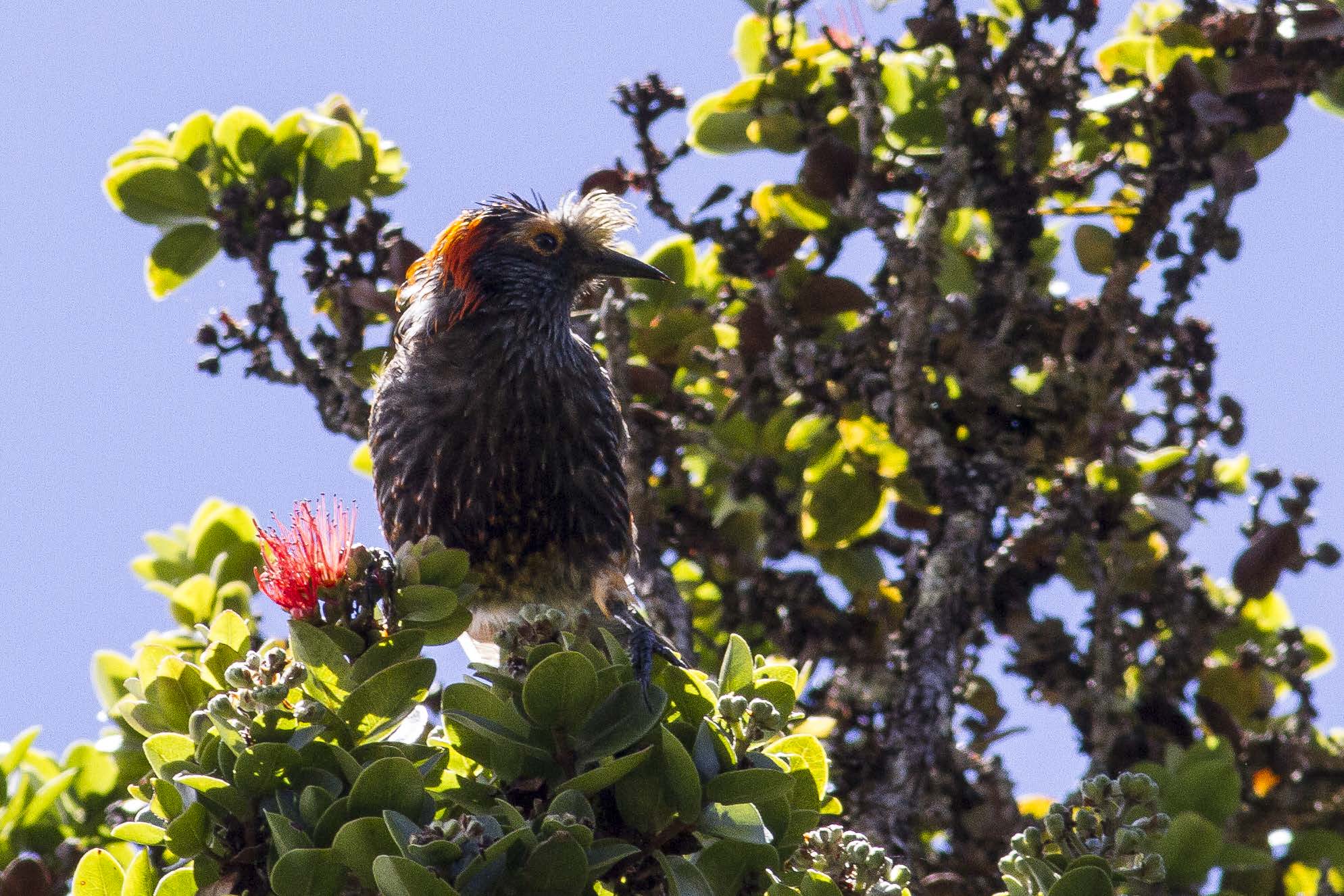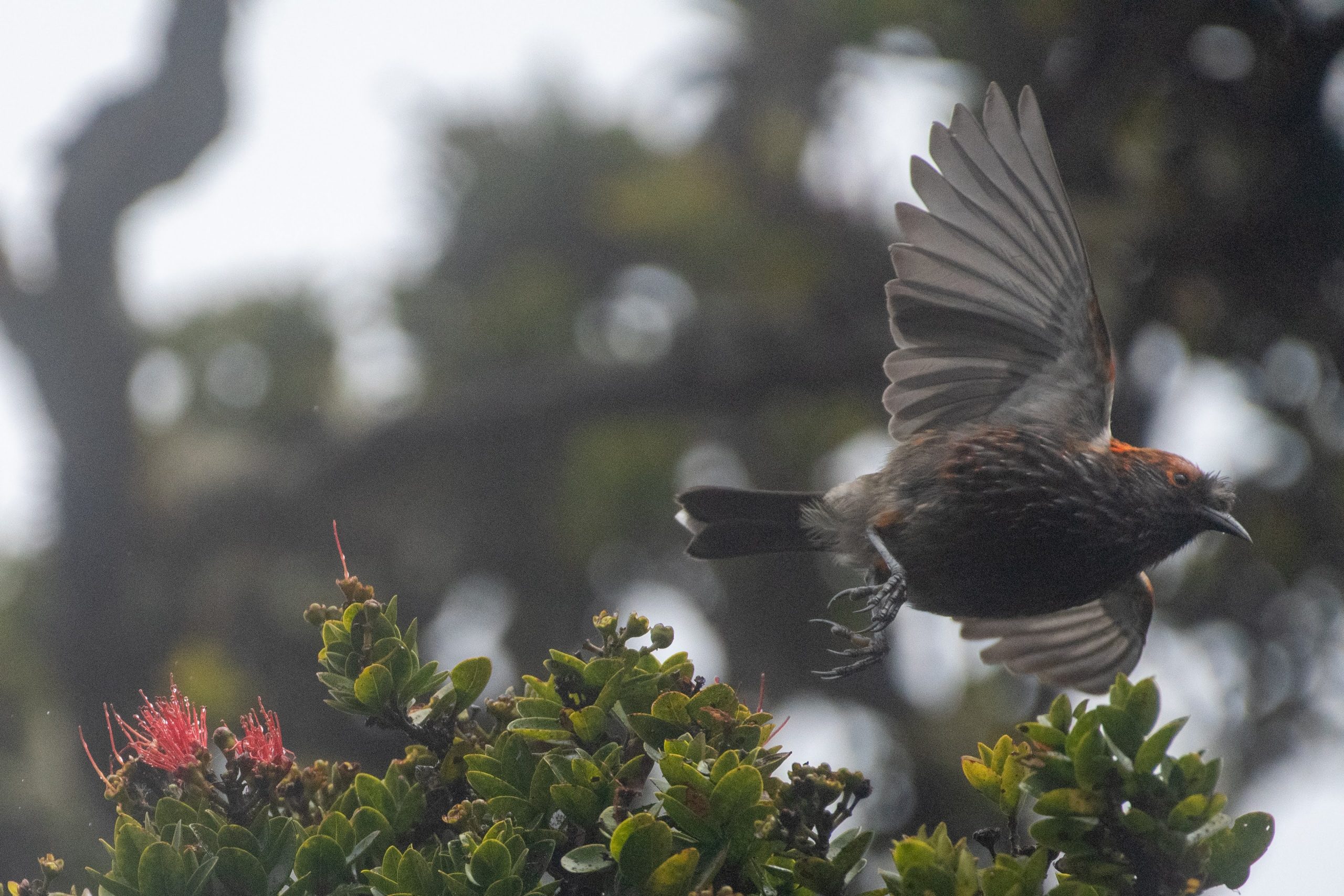‘Ākohekohe
Names
- ʻŌlelo Hawaiʻi: ‘Ākohekohe
- Common: Crested Honeycreeper
- Scientific: Palmeria dolei
Song
Conservation Status
- Federally Listed as Endangered
- State Listed as Endangered
- State Recognized as Endemic
- NatureServe Heritage Rank G1—Critically Imperiled
- IUCN Red List Ranking—Critically Endangered
- Revised Recovery Plan for Hawaiian Forest Birds—USFWS 2006
Species Information
The ‘ākohekohe, or crested honeycreeper (Family: Fringillidae), is the largest extant honeycreeper on Maui Nui (Lāna‘i, Moloka‘i, Maui, and Kaho‘olawe). Although primarily black, the plumage of the ‘ākohekohe is striking. Depending on their location, feathers are tipped with orange-yellow, gray, silver, or white. Orange feathers surround the eyes and extend over the nape, orange or yellow-white feathers cover the thighs, the epaulettes (“shoulders”) are white with orange tips, and there is a distinctive plume of white feathers that curl forward over the bill giving them the name crested honeycreeper. The Hawaiian name, ʻākohekohe is derived from one of the calls they make. They do not sing but produce a random series of buzzes, croaks, and whistles They are primarily nectarivorous, feeding mainly on ‘ōhi‘a lehua (Metrosideros polymorpha), but also from the flowers of other trees and shrubs. ‘Ākohekohe are strong fliers and will move from low to high elevations in search of blooming ‘ōhi‘a. Arthropods, mainly gleaned from ‘ōhi‘a, are also part of the species’ diet. They spend up to 70 percent of the day foraging. They aggressively defend feeding and nesting territories year-round. Females build open-cup nests primarily in ‘ōhi‘a, incubate one or two eggs, and brood nestlings; male feeds female on nest. Newly-flying birds can forage independently 10 to 14 days after leaving the nest. Pairs successfully raise two to three sets of offspring per season.
Distribution
Restricted to a 24 square kilometer (<10 square mile) area on the northeastern slope of Haleakalā at 1,525 and 2,133 meters (5,000 – 7,000 feet) on the island of Maui. Subfossil evidence indicates they once occurred in Maui’s lowland dry forests and in eastern Moloka‘i. They currently occupy 5 percent of their historical range (UH PCSU, 2021).
Habitat
Wet and mesic montane forests dominated by ‘ōhi‘a and ‘ōlapa (Cheirodendron trigynum); koa (Acacia koa) and kāwa‘u (Ilex anomala) occur at lower densities. Nearly all birds occur in forest between 1,828 and 2,134 meters (6,000 – 7,000 feet) elevation in rugged, steep terrain with a dense understory. The entire known range of the species occurs within National Park Service, State of Hawai‘i DLNR, and The Nature Conservancy (TNC)managed lands (UH PCSU, 2021).
Threats
‘Ākohekohe are likely susceptible to the same factors that threaten other native Hawaiian forest birds, including habitat loss and degradation, predation by introduced mammals, and disease. For ‘ākohekohe, the following are of particular concern:
- Disease. Similar to ‘apapane and ‘i‘iwi, movements between low- and high-elevation foraging sites may increase these birds’ exposure to mosquito-borne diseases such as avian malaria and avian pox.
- Habitat degradation. Feral pig (Sus scrofa) damage to understory vegetation may reduce the availability of nectar-producing plants important to ‘ākohekohe, especially those flowering when ‘ōhi‘a nectar is less available.
- Population size. Small populations are plagued by a variety of potentially irreversible problems that fall into three categories: demographic, stochastic, and genetic; the former are usually most problematic. Demographic factors include skewed sex ratios and stochastic factors include natural disasters. Habitat fragmentation exacerbates
demographic and genetic problems.
Plans & Projects
Additional Resources
For more information and references visit the DLNR State Wildlife Action Plan factsheets. DOFAWʻs species pages and State Wildlife Action Plan fact sheets are provided for general information and are not meant to be a citable, original source of data. If you are a student, researcher, or writer looking for a citable source, please explore the references below or find other original data sources, rather than citing these webpages. The references below were provided by the authors of the State Wildlife Action Plan fact sheets at the time of drafting:
- Berlin KE, VanGelder EM. 1999. ‘Akohekohe (Palmeria dolei). In The Birds of North America, No. 400 (Poole A, Gill F, editors). Philadelphia, (PA): The Academy of Natural Sciences; and Washington DC: The American Ornithologists’ Union.
- IUCN Red List of Threatened Species. 2015. Version 2014.3. Available at: www.iucnredlist.org. (Accessed May 2015).
- Scott JM, Mountainspring S, Ramsey FL, Kepler CB. 1986. Forest bird communities of the Hawaiian islands: their dynamics, ecology and conservation. Lawrence, (KS): Cooper Ornithological Society.
- U.S. Fish and Wildlife Service. 2006. Revised Recovery plan for Hawaiian forest birds. Portland, (OR): U.S. Fish and Wildlife Service.



